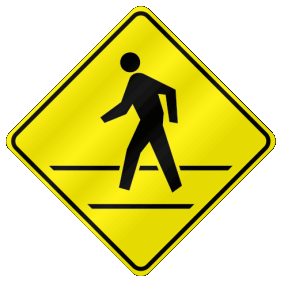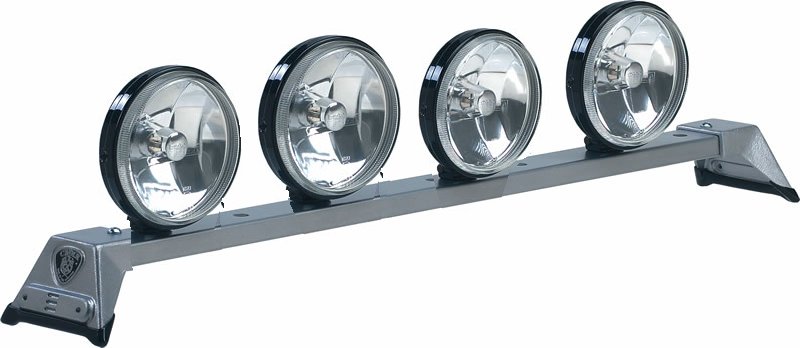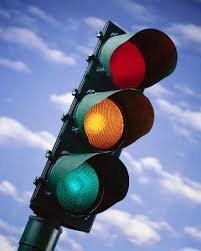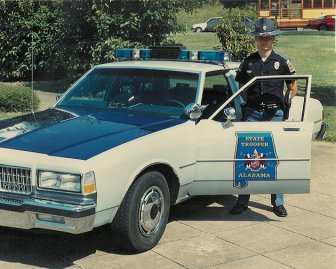A Word From Our Gov’ner:
Welcome to Alabama. Whether you are a new ten-year-old driver moving up from farm tractors to automobiles, or an eighty-year-old driver with two cataracts and a slow response time, this online Alabama Driving Guide will help you to understand and follow Alabama’s Traffic Safety Laws.
When driving in Alabama, it is important that you always drive in the most unconventional and unpredictable manner possible. Doing this keeps other drivers alert and reduces your chance of accidents. Remember, Alabama is the home of the Talladega Superspeedway, and just like our favorite NASCAR driver, the Legendary and fictitious superstar Ricky Bobby, the goal of every Alabama driver is to get to their end-point in the fastest manner possible, by whatever means are necessary.
Right-of-Way Rules:
If you remember nothing else from this
handbook, at least remember this: As an Alabama driver, you have the
right-of-way in all situations.
If anyone infringes on your right-of-way, honk your horn,
curse loudly, and gesture with a single finger to let them know your
displeasure.
Also, you may give up the right-of-way whenever it
amuses you, or whenever you can’t remember the traffic laws. Obtaining eye
contact with another driver automatically rescinds your right-of-way. It is
also a good idea to yield the right-of-way to any vehicle that is bigger and
has more steel than yours, especially if you feel like it will come out ahead
in the event of an accident.
Pedestrians:
Pedestrians do not have the right-of-way. Pedestrians should not be in the cross-walk when the light changes. Pedestrians in crosswalks are considered fair game. A little time in the hospital will remind them that you, as the owner of an Alabama-licensed vehicle, always have the right-of-way. Warning!! if you make eye contact with a pedestrian, you give up your right-of-way.
Safe Traveling Distance:
Under no circumstances should you leave a
distance greater than one-half car length between you and the car in front of
you. “Share the Road” means leave plenty of space for cars to pull in
behind you. If you leave too much space between you and the car in front
of you, it will be filled by some other driver who will most likely be traveling
slower than you are, putting you both in an even more dangerous situation.
Automotive Lighting
The primary purpose of headlights is to remind other drivers that you have the right-of-way. Do not use headlights when driving during daylight hours – it just wastes energy. Unless absolutely necessary, do not use your headlights in towns or cities during hours of darkness. That’s what street lights are for, and you pay for them with your taxes. Also, flashing your high beams at other drivers at night is far more effective when coming from an fast-traveling un-lit car.
In rural situations, headlights can be used to allow you to see the road ahead when it gets very dark. Modern cars and trucks do not come equipped with sufficient lighting for rural driving.
The state of Alabama strongly recommends you purchase a light bar with at least four high brightness krypton beams if you will be doing any rural driving. During hours of darkness, you may use parking lights and spotlights to see along back roads, into deer stands, and in residential neighborhoods.
Emergency Flashers
Turn on your emergency flashers whenever you:
- drive in the rain
- stop for a yard sale
- haul hay
- stop to count cattle in the field
- tow a disabled pickup
- drive slower than the speed limit
- drive faster than the speed limit
- want cars on the highway to get out of the left
lane
- are not sure if you want to turn right or left
- back down an exit ramp
- back up on the interstate
Signaling Your Intentions:
Turn signals give other drivers clues as to your next move.
Alabama drivers should never use them.
Traffic Lights:
Alabama traffic lights have three colors: Tuscaloosa red, Auburn orange (some call it yellow), and green.
A red light means “stopping is permitted”. Right turns on
red are permitted. If you are quick about it, a left turn on red is permitted.
Straight through on red is sometimes permitted. A U-turn on red is permitted.
A yellow light indicates the light is going to turn red, and
that you should speed up. Otherwise, a yellow light should be treated the same
as a red light. Remember, the faster you drive through a yellow or red light,
the smaller your chance of getting hit.
A green light simply lets you know that the red and yellow
light are off, but the traffic light is still working. Never proceed through a
green light without caution. Always look right and left and right and left
again before proceeding, unless you have side impact airbags and good no-fault insurance.
Traffic Signs:
Traffic signs are purely for decoration of
the roadside, they are like advertising; just ignore them. Alabama is
installing new electronic traffic warning system signs along the interstates to
make Alabama look high-tech and to distract your attention from the police car
parked in the median. They are also decorative. Speed limit signs contain
arbitrary figures, given only as suggestions and usually not enforced except on
vehicles with out-of-state tags.
Traffic Lanes:
Crossing two or more lanes in a single
lane change is called “going with the flow”. Never pass on the left if there is
good paved surface you can use to pass on the right. Don’t worry about people
entering the highway; remember, as an Alabama driver, you have the right-of-way.
Using the shoulder of the road, on-ramps, or off-ramps to pass are perfectly
acceptable whenever freeway traffic drops below 50 mph.
Maneuvering Your Vehicle:
When making a turn, announce your
intention to turn by looking straight ahead. If turning right, pull to the left
side of the lane. If turning left, move your car slightly on to the right
shoulder, but keep your left wheels squarely centered in the travel lane. If
any vehicles impede your turn, honk at them and gesture wildly. Remember, as an
Alabama driver, you have the right-of-way.
Safe Braking:
Modern vehicles are equipped with
Anti-lock Braking Systems (ABS). Fortunately, very few cars in Alabama are
modern vehicles. If you do happen to have a modern vehicle, ABS requires that
you brake as hard and as late as possible, a technique called “stopping short”.
Short-stopping insures your ABS system kicks in. What good is it to have the
ABS system if you don’t use it? A side benefit to ABS is the nice, relaxing
foot massage you receive as the brake pedal pulsates If you are in the 80% who
drive clunkers without ABS, you should still practice stopping short. Sort-stopping
is a opportunity to strengthen your leg muscles.
Learn to swerve abruptly. Alabama’s
oyster-shell roads are a great place to learn high-speed slalom driving and
drifting techniques thanks to their naturally slick surface, augmented by the
infrequent rains and millions of Alabama cars that leak oil. Your tax money
allows the Alabama Department of Transportation to maintain potholes in key
locations to test your driver reflexes and keep you an alert driver.
Always slow down and rubberneck whenever you see an accident, someone changing a tire, a hitchhiker, or a vehicle out of gas. It is perfectly alright to come to complete stop in the middle of a street or highway to check an address, especially during rush-hour.
When you see an Alabama State Patrol car sitting in the
median of an interstate, slow down immediately and you will not be stopped. For
instance, if you are driving 20 mph over the speed limit in a 70-mph zone, slow
down to 50 mph for the next two miles. The 20 mph difference between your speed
and the speed limit offsets the 20 mph difference in the speed limit and your
original velocity.
Passing:
Speed limits do not apply while passing.
Before passing a car, tailgate the car in front of you to
signal to the driver that they are going too slow.
Announce your intention to pass by looking straight ahead,
swerving into the left lane, and pressing the accelerator pedal to the floor.
If there is not enough room to pass in the left lane, or you face oncoming
traffic, do not abort your passing maneuver as you will confuse other drivers. Lane
markings are purely decorative, and you should make the most efficient use of
the entire paved surface during passing. Plan your passing move to
overtake a slower vehicle at the next intersection, highway on-ramp, or
off-ramp. Ramps, shoulders, medians and sidewalks allow you extra room for
passing. A two-lane road with shoulders will easily fit three cars
side-by-side; that’s why the shoulders are there. Use the left shoulder to
continue your passing maneuver. Remember, when passing a slower vehicle, you
have the right-of-way.
During the hours of darkness, set your headlights to high
beam to convey your intention to pass, especially on blind curves.
Construction Zones:
Construction Zone signs are set up to tell
you about road closures ahead. They are typically set up immediately after you
pass the last available exit, but before the traffic begins to back up. A lane
closure is just an experiment used by the Alabama Department of Transportation
to see how many vehicles can fit in a minimum amount of space.
Adverse Weather Conditions:
Heavy snows, ice, fog, or rain is no
reason to modify any of the previously listed rules. Should you approach a
heavy snowdrift, icy roads, or flooded conditions, just remember, as an Alabama
driver, you have the right-of-way. These weather conditions are mother
nature’s way of keeping incompetent drivers off our roads. As a side benefit,
it also contributes to a lower Alabama jobless rate for body shop workers, junk
yard owners and new and used vehicle salesmen.
Driving Practice:
Female student drivers should practice
putting on pantyhose and applying eye makeup at fifty-five miles per hour as
well as in bumper-to-bumper traffic.
Going Green:
As a final word, Alabama is embracing the “Go Green” movement. Throw your litter out the window. Throwing litter on the roads adds visual variety to the landscape, keeps existing litter from getting lonely and gives Adopt-a-highway volunteers, the homeless, and Alabama State Prisoners something to do while building their self-esteem.
- I hope you have found this document both informative and helpful in your pursuit of safe driving.








